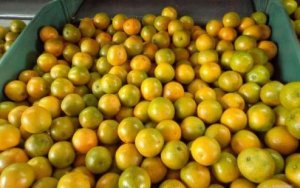 See photos
See photos
Despite the peak of pear orange supply from the 2016/17 in August, the fruit prices continue at high levels in Brazil. As the harvesting of early oranges ended in the first fortnight of the month, exactly when pear orange processing was intensified, the availability of oranges in the in natura market was limited in that period. Regarding demand, the return-to-school period warmed the demand as well and, consequently, pushed up quotes. Besides, the firm weather also boosted orange consumption in that period.
Although pear orange prices in the in natura market decreased 4% from June to July, the average was 19.53 BRL (5.97 USD) per 40.8-kilo box, on tree, a very high level for the period, which is known for the lowest prices in the year. Regarding July/15, for example, there was a sharp 69.4% price increase of that variety, in nominal terms, or 51.7% up in real terms – values calculated by the IGP-DI from June/16.
The high demand from processors underpinned prices at high levels in the first fortnight of August. As many Brazilian citrus growers had already sold their fruit to processors, contracts were prioritized, reducing supply for the in natura market in that period
Data indicating that ending stocks from the 2016/17 crop in São Paulo State may practically finish and that the output from Florida may be the lowest in 53 years increased concerns regarding the global supply of orange juice and the prices of the commodity and the fruit in the first fortnight of August. Supply is low compared to demand, at least until 2017, and, consequently, quotes will keep high in Brazil.
CitrusBR (Brazilian Association of Citrus Exporters) forecasted that 206.74 million boxes of 40.8 kilos will be crushed this season (2016/17) by processors from São Paulo State, an average yield of 291.8 boxes to produce one ton of juice. In this scenario, 708.5 thousand tons of concentrated orange juice would be produced, with ending stocks from the 2015/16 crop at 351.6 thousand tons. Besides, part of the juice to be processed in other states may be traded by processors from São Paulo (17 thousand tons), resulting in a total supply of 1.08 million tons, very similar to the exported amount of juice in one year-crop. With this volume, the Brazilian industry has two options: keep international sales and start next crop without stocks or reduce exports to form ending stocks, although small, for the next season.
Despite a sales reduction, Cepea data show that the orange juice supply may continue low until the end of the 2017/18 crop (in June 2018), because of uncertainties regarding the crop from São Paulo State next season. Processors, to replenish stocks to around 300 thousand tons in June 2018, would have to process around 300 million boxes in the 2017/18 season, at an average yield of 260 boxes to produce one ton of juice – numbers that have not been reached in years.
It is still early for any forecasts related to orange juice and yield in the next crop from São Paulo. However, one of the factors that has limited productivity of orange groves in recent years is the weather – in 2016, the possibility of La Niña in spring brings more uncertainties. In southeastern Brazil, La Niña may make the weather drier, which would limit the fruit growth – affecting the productivity per tree. On the other hand, this scenario may increase the concentrations of soluble solids in oranges, improving the industrial yield. The greening advance in orange groves from São Paulo State and the recent reductions of investments in new plantings also limit productivity.
Source: Hortifruti/Cepea